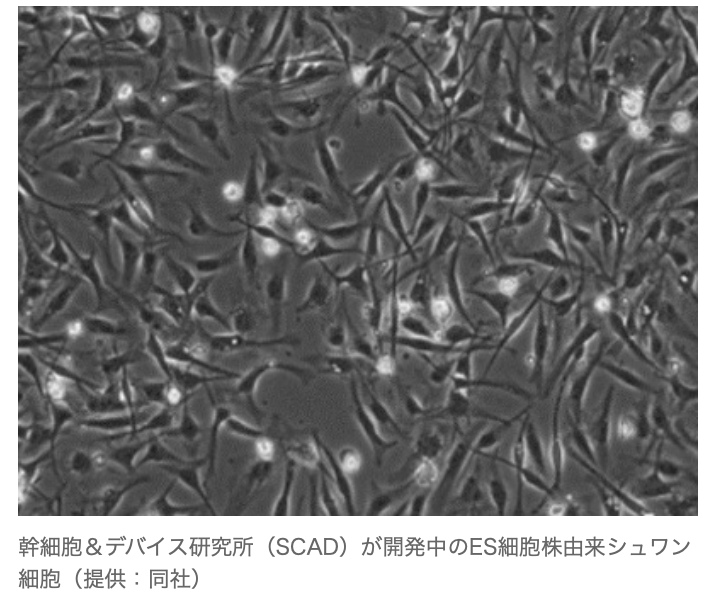https://bio.nikkeibp.co.jp/atcl/news/p1/24/09/13/12361/
Stem Cell & Device Laboratory (Kyoto City, CEO Kato Kensuke, hereinafter SCAD), a startup from Kyoto University, is developing human iPS cell-derived Schwann cells as a regenerative medicine product to treat damaged nerves. The first target is carpal tunnel syndrome, and the plan is to begin investigator-led clinical trials after 2026. On September 6, 2024, data from animal experiments using SCAD’s Schwann cells was presented at the 35th Annual Meeting of the Japanese Society of Peripheral Nerve Research.
The company was founded in May 2014. The company’s top advisor is Professor Emeritus Norio Nakatsuji, who served as director of the Institute for Frontier Medical Sciences (now the Institute of Medical and Biological Sciences) at Kyoto University. Using the technology of arranging cells in a certain direction and culturing them in three dimensions to form and mature specific tissues, and the technology of inducing differentiation of iPS cells into nerve cells, etc. as the base technology, we have developed and commercialized disease models for drug discovery screening. In the process, we have succeeded in inducing Schwann cells from iPS cells and ES cells with high efficiency and quality, and have begun developing regenerative medicine products.
It has been reported that Schwann cells have the function of repairing damaged nerves. When a nerve is damaged, Schwann cells (1) migrate to the damaged site, (2) process the damaged cell debris together with macrophages, etc., and (3) secrete neurotrophic factors such as NGF and form a foundation for axon regeneration. This action is thought to regenerate the damaged axon. SCAD CEO Kato and Director Nakatsuji believe that “Schwann cells migrate to the site of nerve damage and, in addition to secreting neurotrophic factors, have various effects such as processing cell debris and creating axon scaffolding, so they have a higher repair effect than mesenchymal stem cells, whose main function is to suppress inflammation.” To date, efforts have been made to extract Schwann cells from autologous human nerve tissue and transplant them, and it has been reported that they have been effective in treating spinal cord injuries.
However, there have been almost no examples of the development of Schwann cells derived from allogeneic cells that can prepare a sufficient number of cells for transplantation. SCAD has established a method to induce the differentiation of Schwann cells from allogeneic iPS cells and ES cells. It has developed and patented its own differentiation induction method, such as using factors that work to induce differentiation and enzymes in specific combinations. Part of the research results was published in a paper in the journal Biochemical and Biophysical Research Communications (BBRC) in July 2024.
SCAD has previously conducted an experiment in collaboration with Kyoto University in which it transplanted Schwann cells derived from human iPS cells that it had produced into a rat model of sciatic nerve crush injury (bruise, injury caused by pressure). When Schwann cells were injected around the damaged sciatic nerve, after four weeks, there was a significant improvement in (1) the recovery of damaged axons, (2) the muscle action potential when the motor nerve was stimulated, (3) the response to stimulation of the rat’s paw, and (4) the motor function of the rat’s paw.
In this experiment, four weeks after transplantation, there were no Schwann cells derived from human iPS cells remaining in the rat’s body, and the myelin sheath of the sciatic nerve had been regenerated with the rat’s own cells. Director Nakatsuji and CEO Kato say, “The transplanted Schwann cells promote the regeneration of axons by processing damaged cell debris and secreting neurotrophic factors, and encourage the regeneration of myelin by the host Schwann cells. In experiments with rats, the transplanted Schwann cells disappeared and no abnormal cell proliferation was observed. Therefore, we believe that SCAD’s allogeneic Schwann cells have a low risk of abnormal proliferation or cancer of transplanted cells, and there are few safety concerns such as tumorigenicity.”
To reduce treatment costs, the company plans to mass-produce Schwann cells and transplant them without matching the HLA of the patient and the transplanted cells. Although it may be necessary to administer immunosuppressants, this has the advantage of reducing the administration period and dosage.
SCAD is currently conducting research into the clinical application of allogeneic Schwann cells. The company plans to use ES cells as a cell source for clinical use. “We use high-quality ES cells for clinical use, which are distributed almost free of charge as a public project of the Human ES Cell Research Center at the Institute of Medical Biology, Kyoto University, and which are not subject to any patent restrictions. ES cells also have the advantage of having less variation in quality compared to iPS cells,” said Nakatsuji, the company’s director.
First, between 2024 and 2025, development will be underway to select the most suitable ES cell strain for producing Schwann cells, optimize and streamline the production method for clinical use, and scale up the process. “By tweaking the production process, we are looking at being able to produce enough for 100 to 1,000 people at a time, even by hand,” said Nakatsuji. The company aims to begin clinical trials after 2026.
The first target disease will be carpal tunnel syndrome, a condition in which the peripheral nerves in the hand are compressed, causing pain, numbness, and paralysis in the fingers. The company plans to administer the drug locally to severe cases in investigator-initiated clinical trials. For carpal tunnel syndrome, a phase 1/2 investigator-initiated clinical trial is planned for 2026 and after, led by Professor Ryosuke Ikeguchi of the Department of Rehabilitation, Kyoto University Hospital. Professor Ikeguchi commented on SCAD’s allogeneic Schwann cells, “In rat experiments, improvements were seen in items highly related to the clinical evaluation index of carpal tunnel syndrome, and clinical effectiveness is expected.” The company plans to apply for approval with the data and then begin clinical development in the United States as soon as possible.


